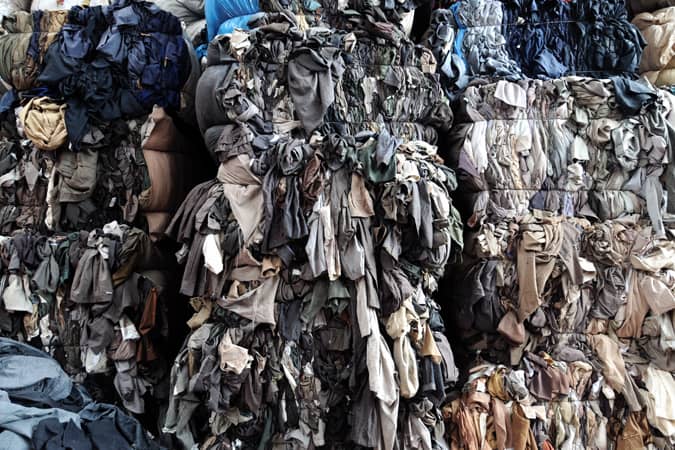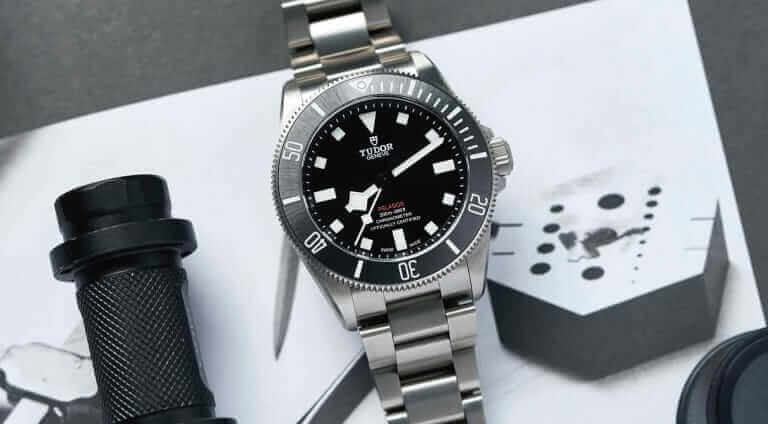Slow Fashion: The Stylish Guide To Dressing Sustainably

We live in a fast-paced society in which keeping up with the latest fashion trends has become both a dash and an ultramarathon without a finish line. A constant pursuit of newness.
At one end of the scale, luxury fashion brands produce up to six collections a year: all the seasons plus cruise or resort. At the other end, online retailer ASOS stocks up to 60,000 styles at any one time, and will constantly update its inventory according to what’s trending.
The problem is, fashion – the way clothes are relentlessly produced, promoted and consumed – is killing the planet. In 2015, greenhouse gas emissions from global textile production totalled 1.2 billion tonnes of CO2 – more than the emissions of all international flights and maritime shipping combined. Water usage is biblical: to produce the cotton for a single T-shirt takes 2,700 litres of water – enough water for one person to drink for 900 days.
Meanwhile, rivers across the world are boiling with some of the 8,000 synthetic chemicals used to turn raw materials into final products. And for what? Of the 150 billion pieces of clothing produced each year, most are kept for less than three years and less than one per cent of the material used to produce them is recycled into something new at the end of its life.
Slow fashion is one of the proposed solutions, a means of being stylish but not wasteful.
The Principles Of Slow Fashion
In the past 15 years, global textile production has doubled to meet demand – and it’s not letting up. The industry is set to expand still further: by 63 per cent by 2030. And most of the blame is laid at the feet of fast fashion, the accelerated business model that churns out cheap, badly made gear hundreds of times a year. What’s more, according to consultants McKinsey, more than half of fast fashion items are chucked out in less than a year.

Of course, fast fashion wouldn’t exist if we didn’t hoover up the stuff like there was no tomorrow (which, at this rate, there may not be). In previous generations, garments were locally sourced and produced. People would sew their own apparel – or buy garments that lasted. Clothes were linked to time and place; they expressed culture and community and offered protection against the elements. According to the theory of slow fashion, we need a bit more of that in our lives.
Originally highlighted by Kate Fletcher at the Centre for Sustainable Fashion, slow fashion is an approach that considers the processes and resources – plants, people, animals – required to make clothing. There’s a particular focus on sustainability: on respecting the planet that provides the raw materials for our clothes and for the people who make them, their welfare and their skills.
And for the consumer, it means slowing down, buying new togs only when you need them and seeking out better made, better quality items. For the fast fashion addict, this will present something of a challenge. But for the man whose signature style is forged in ideas of history and personal identity rather than on the vicissitudes of high street icons, it’s a piece of cake.
If you like raw denim, wax jackets or work boots that will last you a decade or more, you’re already in the slow lane. Now, as the wider industry wakes up to the need for sustainable fashion, there are more slow styles catering to wider tastes than ever, streetwear included. Want in? Here’s what you should be looking for.
Great Materials

There’s a reason why fast fashion purchases often fall to bits: they’re often produced using bottom-line materials. Part of this is due to the speed of production: short lead times mean that wash tests and wearer trials are often not feasible for brands rushing to get new lines on sale. The other factor is cost: it’s cheaper to create a blend of synthetic fibres than it is to invest in the real thing. Luckily, there are ways to test fabrics – in store.
Ball part of the garment up in your fist, hold it for a few seconds, then let it go. If the fabric stays wrinkled, it’s probably not going to withstand the test of time. Gently pulling on the fabric tells you the same thing. And the devil really is in the detail: zippers, seams, buttons and buttonholes should be firmly sewn and neat. Zippers should be covered; jackets should be lined.
It’s here that the debate around natural versus synthetic may start to take hold. Cotton, which makes up 40 per cent of all clothing produced is a thirsty, pesticide-reliant crop which has drained inland seas the world over. It is also natural: soft, strong, biodegradable and recyclable. Its closest rival in the industry is polyester, derived from coal and petroleum, horrendous for the planet in every possible way.
Polyester has more than double the carbon footprint of a cotton shirt; takes between 20 and 200 years to break down in landfill, leaching toxins into the soil; and, with every wash, it releases microfibres into the oceans. But, boy, can it stand the test of time. There are conscious fashionistas who say that one polyester garment – as long as it’s used for years – is more sustainable than umpteen pieces of eco-friendly clothing. The (complicated) choice is yours.
Buy Local
 Private White V.C.
Private White V.C.
For centuries, the textile industry was a vital part of the British economy, with entire communities built around flax and wool, yarn and cloth. Today, old mills and factories, relics of Britain’s manufacturing past, pepper the North West, their work undercut by low prices in developing countries. So, if you’re already a fan of British made, give yourself a big pat on the back.
Slow fashion loves UK-based brands. Firstly, bar exceptions such as Burberry and Dunhill, they tend to be compact and family-run. Secondly, they have a penchant for sourcing and making in the UK, reducing the impact of air travel: Pringle still has its HQ in the Southern Uplands; shirts by Turnbull & Asser are cut and sewn together in Gloucester. Private White VC employs 75 people in its Manchester factory, sourcing as much as possible from historic mills.
Last but by no means least, local brands tend to create smaller wardrobes of classic styles that will endure. Slip on one of Barbour’s wax jackets or one of Grenson’s iconic brogues and you genuinely have a piece for life. They’ll cost more but, in the long run, one piece of well-designed, well-produced clothing will outlive a dozen pieces of cheap garms.
Visit Indies

Walk through the doors of a high street behemoth – rails heaving with thousands of crinkled T-shirts and badly cut denim – and you’ve reduced your chances of buying slow and ethically by, oooh, 99.99 per cent. In the world of slow, small really is best.
Rediscover the tight but perfectly curated selections of independent menswear stores Manchester’s Oi Polloi (a spicy mix of Post Overalls, Margaret Howell and OrSlow) or End Hunting Co’s library, in Newcastle, of luxury and progressive labels including Thom Browne and Aspesi, Sperry, Band of Outsiders and Quoddy. Dover Street Market in London, still stands out for brands so cutting edge, they’ll hurt.
Look After Your Clothes

Recycling charity WRAP estimates that extending the life of clothing by just an extra nine months could reduce carbon, waste and water footprints by around 20 to 30 per cent. No one wants to quote ad lib from Mrs Beeton’s Book of Household Management but, seriously, a bad wash can end a good garment. If laundry isn’t your speciality, these are a few starter points.
First up, don’t wash so much and don’t wash so hot. Heat can break down the fibres of the fabric and cause the garment to shrink and/or age prematurely. It’s another reason for rarely if ever dry-ironing. Store them properly (not the floordrobe), on wooden hangers or, in the case of T-shirts, folded. Final tip? Dab out stains with care: a wet cloth and a dab of washing up liquid, gentle pressing and an overnight soak before washing normally.
If taking up the needle is a step too far, it’s good to know that brands such as Nudie Jeans and Tom Cridland’s 30 Year Collection offer free repairs while Patagonia and
Reconnect
These are all just words on a screen if we don’t transform the way we see fashion: from the kick of the new to sartorial companion through life. It’s not entirely our fault. Cheaply produced clobber that degrades too easily or falls out of style too fast is hardly likely to inspire lifelong devotion. And this is where the ideas of slow fashion really come to the fore.
If we handle a garment and feel its heft and the care that’s been taken in its construction; if we can see, in our mind’s eye, the land the fibres have been grown in; if we know the history of its factory and the stories of the craftspeople; if we’ve bought it from a store where we’ve discovered a shared interest with the owner over the counter; if we’ve sewn on a button and mended a tear in it, then we’re more likely to love it.
And that, in the end, is what slow fashion is all about.
The Best Slow Fashion Brands
STORY mfg
The brands above make sterling efforts and deserve pride of place – and years of use – in any decent wardrobe but a few labels are gunning for the 360. STORY mfg works with dyers, weavers, embroiderers and tailors in the Indian forest to create extraordinarily good-looking togs that are animal-kind, organic and dyed with plants.

Wawwa
Young urban wear brand WAWWA mirrors the passionate vegan beliefs of its founders but its efforts go further than that. All the clothes are made in a carbon neutral factory from organic cotton and recycled PET and delivered to you in plant-based packaging.

Rapanui
And, in a technical first, Rapanui – which creates T-shirts for Katharine Hamnett and dozens of charities besides – turns its old organic T-shirts into new, again and again and again to model part of a genuine circular economy. The time has never been better to take it slow.

Raeburn
Ten years of work by Christopher Raeburn haven’t dimmed this sustainable designer’s fire. One of the earliest pioneers in the circular economy continues to burn bright, both on the catwalk and during his open workshops, which show fans how to make his now iconic soft toys from offcuts.

Veja
Sorry to

Read the original article here






